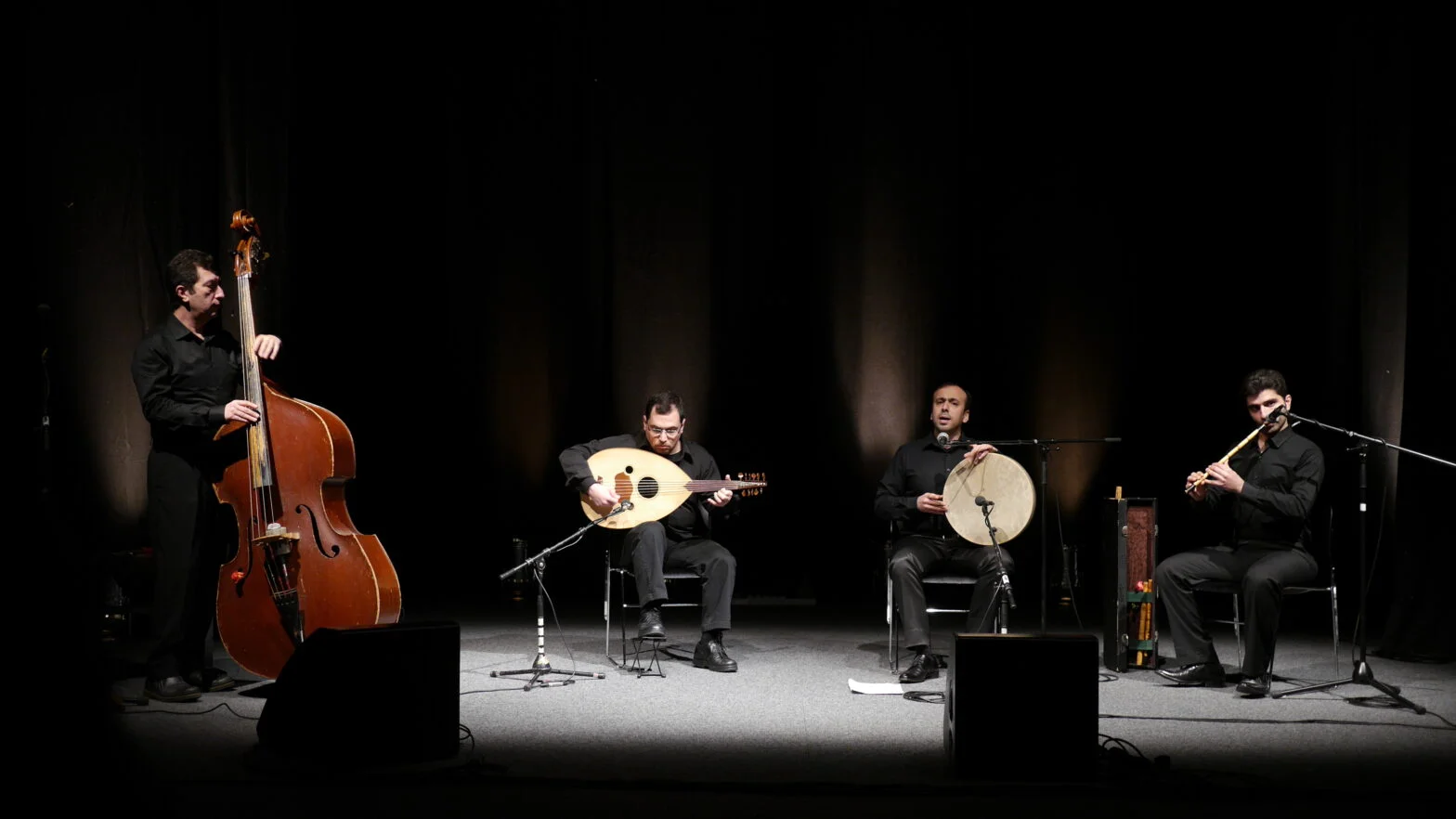by Prof. Hassan Abbas
Throughout history, the Levant has been a melting pot of different people and some of these groups have lived there so long that it is difficult to trace back when they came to the region. Others arrived through large-scale migration fleeing catastrophe in their countries of origin. Some of these groups have disappeared, and their cultures along with them. Others became established in the region and maintained their cultures and traditions.
Today, several musical traditions with different sources co-exist in Syria. Arab, Kurdish, Yazidi, Circassian and Armenian traditions are the main and most prominent ones amongst them.

Arab Music
Traditional Arab music and singing as we know it today started to take its form in the Umayyad period (661-750 AD). When the Rashidun caliphate ended and the Umayyads took over in 661 AD, they started to build magnificent palaces in the caliphate’s capital of Damascus. It was the place, where musical performance from different regions were brought to, in a time when the first writing about Arab music appeared: the “Book of Tunes” (Kitab an-Nagham) was written by Yunus al-Katib.
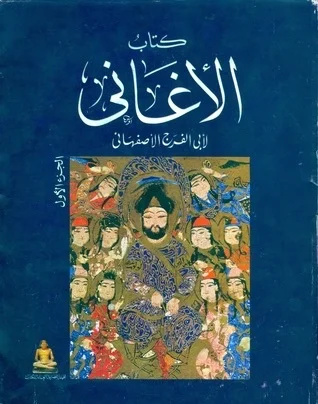
Arab music flourished in the Abbasid period during which literature about music was produced, such as the ” Book of Songs” (Kitab al-Aghani) by Abu al-Faraj al-Isfahani. The musician Ziryab (787-852 AD) created a paradigm shift when he moved to Andalusia and established the first school of song and music that influenced both the west and the east, as well as the birthplace of a new musical genre, the muwashshahat.
In the Hamdanid period, Aleppo became one of the main centres of Arab culture. The court of the ruler Saif ad-Dawla al-Hamadani (944-967 AD) was the meeting place of the poet Abu at-Tayyib al-Mutannabi and the musician and philosopher Abu Nasr al-Farabi, who wrote studies about the nature and harmony of voices. The invention of the qanun is attributed to al-Farabi.
In the Ottoman period, instrumental forms such as the Peşrev and the Samaʿi were established, along with vocal forms such as dawrs (adwar). The music of the Levant was also influenced by the Mevlevi Sufi order created by Mawlana Jalal ad-Din ar-Rumi (1207-1273 AD) in Konya.
In the nineteenth century, up until the end of the first quarter of the twentieth century, extensive song composition were formed. The muwashshahat form flourished in both religious and secular settings. And musical theatre emerged with the Syrian artist Ahmad Abu Khalil al-Qabbani who was forced by Damascus’ conservative community to move to Egypt.
At the beginning of the twentieth century, the major Syrian cities of Damascus, Aleppo, Homs and Latakia witnessed vibrant musical activity thanks to their music clubs. These clubs were able to establish their presence in spite of the difficulties they faced due to various factors, in particular religious and social beliefs. Most members of these clubs were male intellectuals, reflecting the late entry of women into public life at that time, particularly in the arts. In the private arena, on the other hand, in which traditional culture was produced and conveyed from one generation to the next, women had a strong presence, particularly in traditional music education and the revival holding of women only celebrations. Khoja were female singers in Aleppo. Khoja groups are considered carriers of one of the traditional forms of music that women were skilled at.
The term “Arab music” first appeared in a book by Baron d’Erlanger, who helped to prepare the first Arab music conference in Cairo in 1932 AD. Today, the term is used naturally, in particular to distinguish Arabic music from Ottoman music, with which it shares many aspects.
Traditional Arab music appears in lyrical and other musical forms:
| Main lyrical forms
Qasida (poetry piece)
Traditionally, the singer performed a qasida without musical accompaniment. The melodic improvisation of the qasida has developed to the extent that it has become the main part of the qasida in present times.
Layali
A solo sung improvisation of the words “Ya ʿayn ya layl” O eye, O night” repeated many times
Mawwal
A type of improvised metrical or non-metrical song, based on the folk poetry form, with light improvisation. It has an important place in social events and concerts.
Tawshih
The most common metrical type of song in classical religious or secular Arab music in Syria. There are muwashshahat in colloquial poetic forms and others in classical Arabic poetic forms with various metres and sections. There are also subdivisions of the different types of muwashshahat depending on the number of timings and rhythmic cycles.
Dawr
A vocal form of Egyptian folk origin, performed by one main singer accompanied by a chorus (backing vocalists) in some sections. The singer is accompanied by a musical instrument but the role of instruments is secondary.
Qudud
Songs based on religious or secular melodies using the popularity of these melodies to achieve visibility of the new composed song. This new song is therefore tailored after the measurement (qudud, Singular of qadd) of the original melody
| Main instrumental musical forms are:
Taqsim
Improvisation whose only structure is the general mood of maqams chosen by the musician. The taqsim can be performed by any musician in the group, particularly the oud player.
Dulab
A simple instrumental entrance intended to precede lyrical sections. The dulab consists of several mainly short lyrical sentences that are repeated twice and then followed by another sentence by a different person who repeats all the sentences two or three times.
Peşrev
Instrumental musical form that gets its name from the Persian word “pesh-ru“, meaning “that which goes ahead”. It is thus understood that it is mainly an introduction to the wasla (musical segments).
Sama’i
Musical form that has the same purpose as the peşrev in a concert programme but is shorter and simpler. For this reason, it can be performed after the Peşrev, alone before a wasla, or in the middle of it to set the mood and maqam for what comes next.
Tahmila
The tahmila form is made up of two segments, with a short rhythmic scale that has a soft and regular movement. The first section consists of members of the group playing the verse repeatedly in an unspecified and unified manner. The second section is the response to the first section for an equal amount of time during which one of the group’s musicians plays the verse.
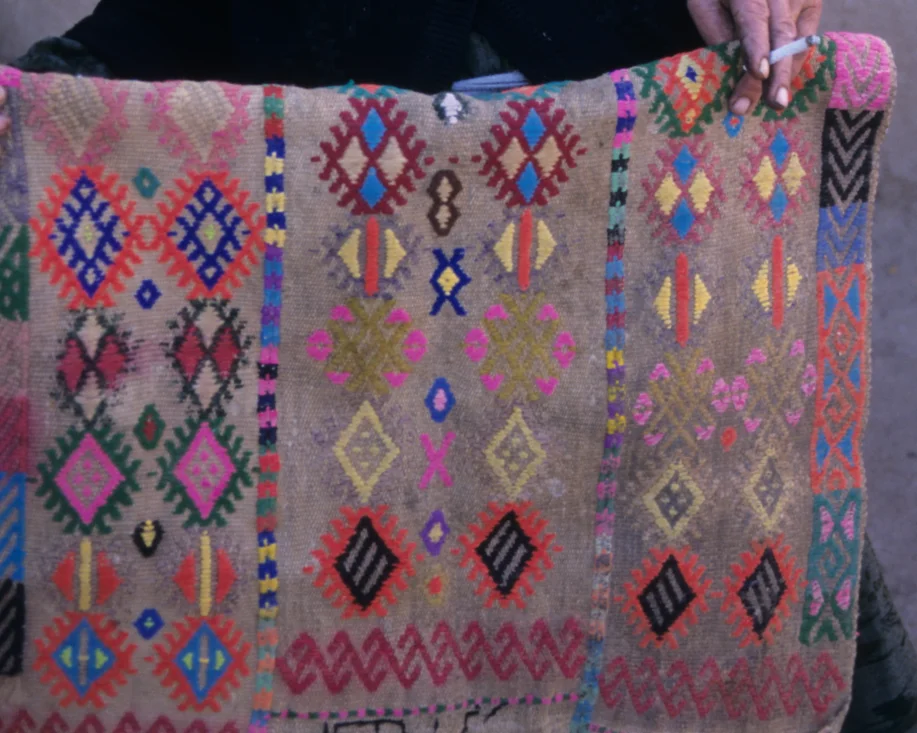
Kurdish Music
During the Ottoman period, the Kurds lived an established and almost independent life in their historical land of Kurdistan with local autonomy by Kurdish rulers appointed by the Ottoman sultan. After the fall of the Ottoman Empire and the division of the region, the Kurdish people were dispersed across the territories of four states: Iran, Turkey, Iraq and Syria. They still do not have an independent state. As the Syrian authorities didn’t allow educational institutions that teach the Kurdish language and culture, traditional music played an important role in protecting their Kurdish cultural identity in light of the suffering of the Kurds in the countries they were dispersed in. This suffering is reflected in the maqam called the “Maqam Kurd”.
Special instruments are used to play Kurdish music, such as the Kamança, related to the singing of folk sagas and legends. It has four strings and a piece of leather over a box. There are other string instruments, such as the santur (Sentûr), tanbur (Tenbûr), wind instruments, such as the flute (Pîk), zurna, bulur (Bolûr), pipe (Cûzele) and percussion instruments, such as the tambourine (Defik) and drum (Dahol).
A large number of Kurdish singers and musicians have become famous in areas Kurds in Syria live in, such as Kara Bayt Khajo (1907-2005 AD), the singer of Armenian origin Aram Dikran, or Tigran (1934-2009 AD), the Kurdish artists Muhammad Shaykhu (1948-1989 AD) and Said Yusuf, born in 1947 in the Jazira region, the tanbur player Adik in Afrin, Baqi Khidr, the poet and singer Mashbuk Abur, the musician and violin player Muhammad Duman, and the composer Rashid Sufi in Kobani.

Yazidi Music
The Yazidis are a small community in Syria. They are the only people in the Middle East region who venerate music and musical instruments, particularly the Tanbur. The legend says that when God ordered the angels, led by Melek Taus, to convert the earth which was submerged under water into dry land, they wanted to established a tent for themselves in one place (this would become the sacred site of Lalish). However they could not find pegs to fasten their ropes, so the enlightened and wonderful musician, Qadi Shalo, brought out his tanbur and started to play his song, which is still being sung to this day. The fish extended their heads and turned into pegs which the angels used to fasten the ropes for their tent. They settled there and started to build on an order from God. This is the story of how the tanbur became a sacred instruments for the Yazidis.
Music also has a special relation to the religious rituals and rites of the Yazidis as these rituals can only be carried out if they are accompanied by a special group of musicians called Qawwalun. They have a hierarchical chanting system with three ranks. They are responsible for commemorating religious events during which they chant hymns preserved and handed down through generations. Thereby, they also use the other two sacred musical instruments the daff and the shabbab.
With their songs and instruments, the Qawwalun take part in collective Yazidi rituals, such as burying the dead and commemorating them. There are also religious rituals, whereby they carry out the blessing of sacred musical instruments by touching them with their hand and then kissing them. Festivals often involve the recital of Yazidi sagas in Kurdish that tell of a hero called Darwish Abdi. Religious festivals go on for hours and end in collective dancing open for people from all kinds of religions. They use musicians, who are not Qawwaluns, who use instruments that are well-known in the region, such as the zurna, the mijwiz and percussion instruments, particularly the drum.
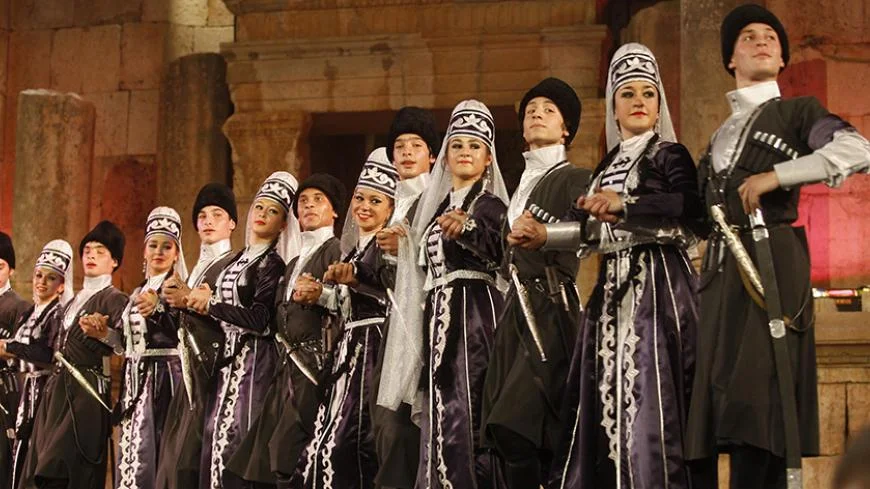
Circassian Music
Circassians are originally from the Northwest Caucasus region. On 21 May 1864 AD, the Caucasian War ended between the native people of the Caucasus and the Russian Imperial army. As a result of the war the various Circassians groups were defeated and had to leave their lands. Some of them migrated to areas under the control of the Ottomans until the Ottomans divided them across the territories they controlled according to their military and economic needs. In this way, the Circassians came to Syria where they were given the task of dealing with raids by Arab tribes on caravan routes along the Euphrates or protecting transport routes between Hauran, Mount Hermon and Lebanon. They were also used as free labour for the project to extend and protect the Hijaz railway.
Syrian Circassians have a deep attachment to their culture. That is why the culture has remained among them despite their integration into host communities and becoming an inherent part of their demographic fabric. Music, along with dance, make up two authentic components of Syrian Circassian culture passed down from one generation to the next.
Traditional Syrian Circassian music uses special instruments such as the Pshina (Circassian accordion), a truly Circassian instrument. There are string instruments: Apa-Pshina, Shchepshine , percussion instruments: Baraban (medium-sized drum), Pkhachich, Pkhetaw and wind instruments: Qamlapsh.
Circassian traditional dance is considered an integral part of Circassian culture. Some Circassians believe that dance become a record of Circassian history after they lost their written records through wars and the displacement policy they were subject to in the nineteenth century. Dances still performed today by Circassian communities include the aristocratic Kafa (Kafe), the rousing bislamiya (Islamey) and the communal wij dance.
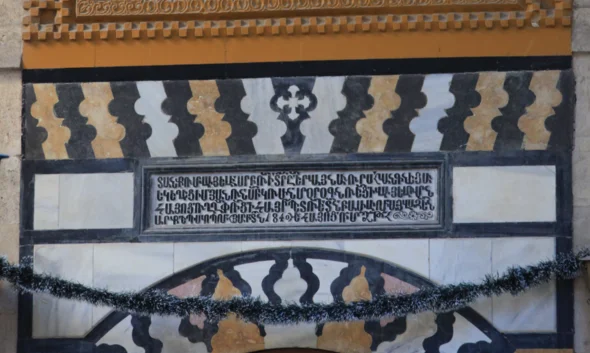
Armenian Music
Armenians who are rooted in Syria and are residing in the northwest of the country, particularly in the Kasab region, have maintained some traditional songs and chants that have been conveyed orally down through the generations. Armenian migrants also brought some of their musical heritage with them. Since they first settled in Syria, the Armenians have been eager to maintain their traditional music. They have set up a number of cultural associations for this purpose to ensure that their culture is taught to future generations.
Armenian traditional music uses instruments that are similar to Arab, Turkish and Kurdish instruments, such as the oud, kamanja (cello or violin), qanun, tar, zurna and some special traditional instruments. The duduk is considered a thoroughly Armenian musical instrument. It is a wind instruments similar to the flute. The first duduk was used more than 3000 years ago. It is made from Armenian apricot wood and thus has the Armenian name of “apricot trumpet”.
Continue with Folk Music
Feature Image: © Hannibal Saad
Prof. Hassan Abbas was the Program Director of “Culture as Resistance” at the Asfari Institute for Civil Society and Citizenship, American University of Beirut and a leading scholar and expert on Syrian culture, and Syrian traditional music in particular. In his book ‘Traditional music in Syria’ Dr. Hassan Abbas distilled his knowledge of years of extensive research on the musical tradition of Syria. His book is available in Arabic here.
After having battled a long-term illness, Prof. Abbas died in March 2021. The team of the Interactive Heritage Map of Syria project is forever thankful for having had the chance and privilege to work with Prof. Abbas and learn from his brilliant mind.
